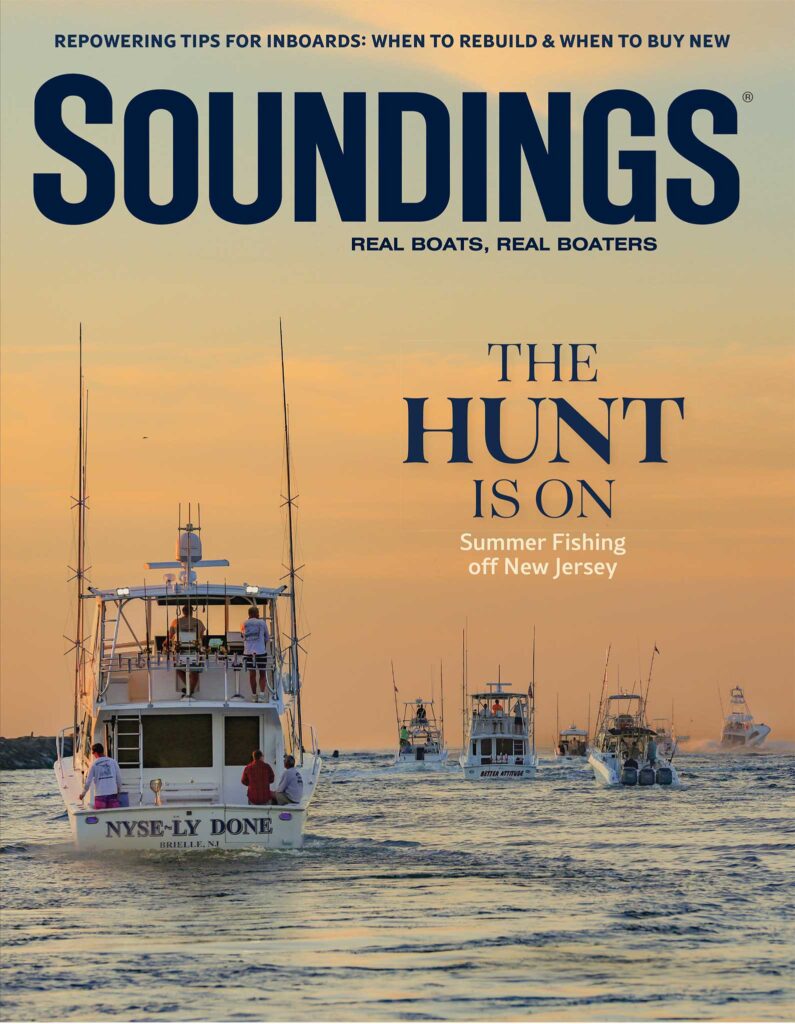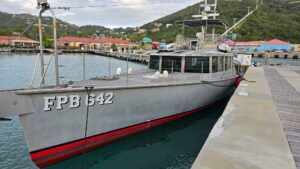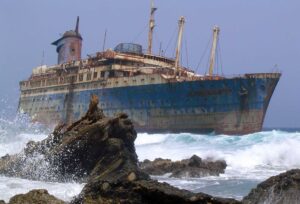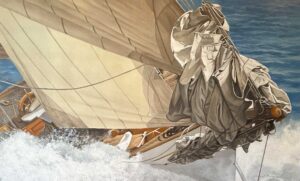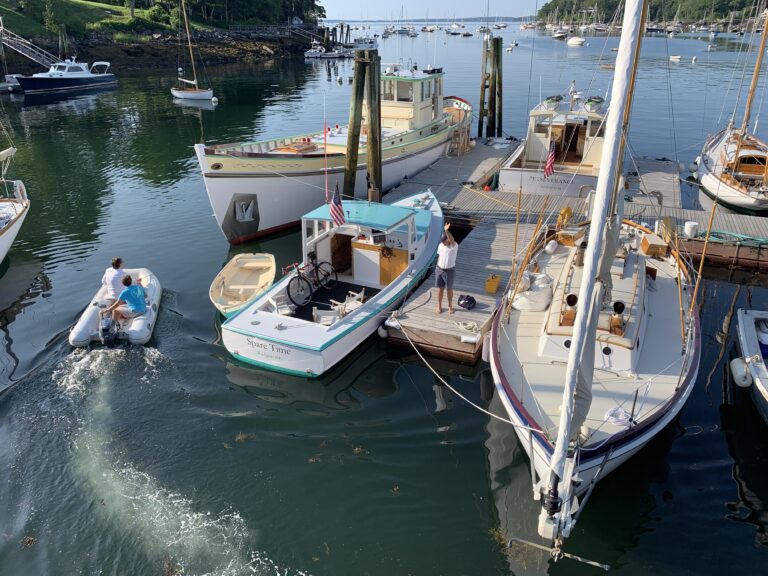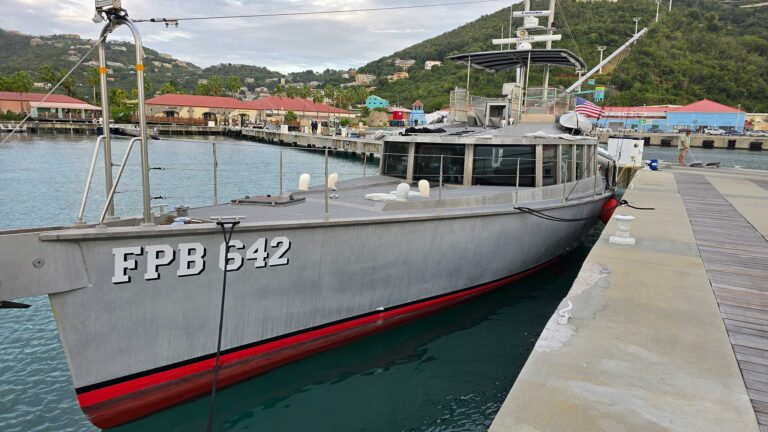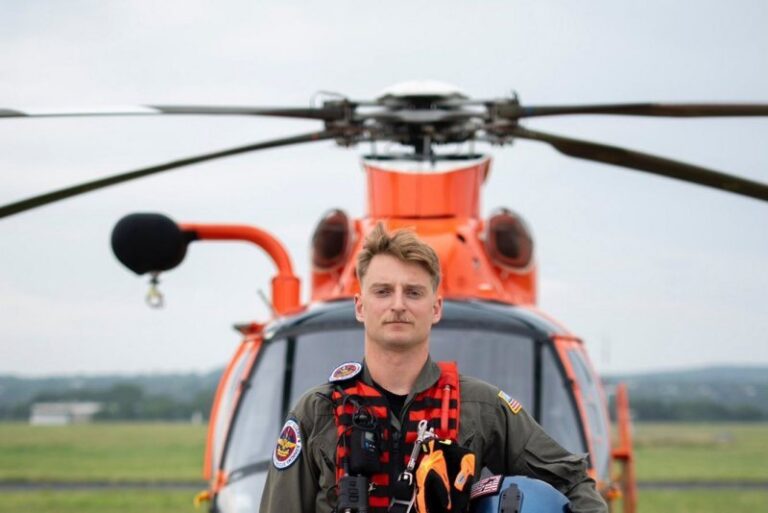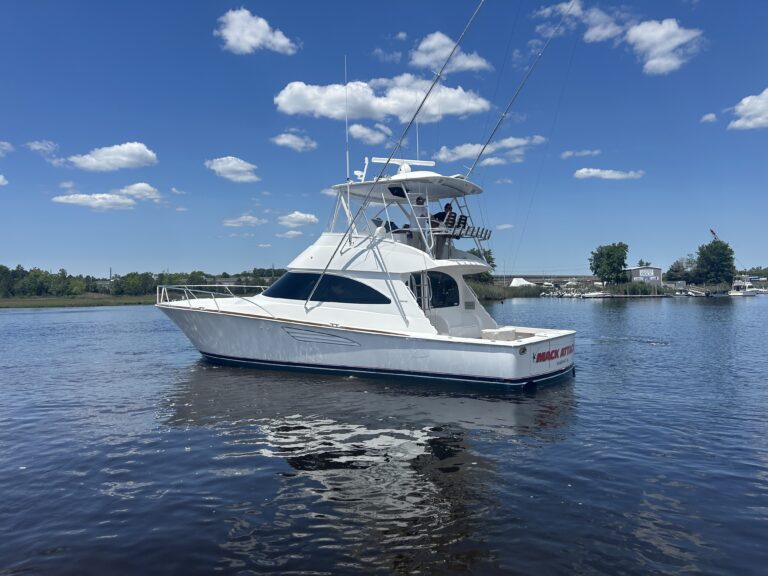In offshore fishing circles, the 42-foot Merritt is instantly recognizable. The design combines a seaworthy hull and timeless good looks with the critical elements needed for big-game fishing. And the best of the best covet these boats because they were purpose-built for catching big fish.
Few older sportfishing boats have the bones and receive the care required to survive 50 years of hard fishing. That cannot be said of the Merritt 42 Picaflor—Merritt hull No. 18—which launched in the spring of 1969. She has been updated and maintained throughout her illustrious career because she has that special something, a pedigree instilled by her builder.
Few boats have caught the number of big fish that Picaflor has. She’s fished the Atlantic and Pacific, as well as the Caribbean. Seven of the sport’s most distinguished captains have manned her helm. She’s had International Gamefish Association Hall of Fame anglers in her fighting chair, set world records and won tournaments. And that’s just a sliver of her storied history.

The Original Build
A young Roy Merritt stood alongside an overturned 42-foot hull in the fall of 1968. He was learning the boatbuilding trade from his uncle, Buddy Merritt, and the talented crew at his grandparent’s modest yard, Merritt’s Boat and Engine Works in Pompano Beach, Florida.
Roy and the crew had recently completed a 42-footer for him and his father, Allen, to be used for family snapper trips. Powered with a single, slightly used 6-71 General Motors Detroit Diesel, Caliban—the name of all Merritt family boats—was the yard’s 17th hull. Merritt 34-, 35- and 37-footers had established quite a reputation on the bluefin tuna grounds of Cat Cay and Bimini in the Bahamas during the 1950s and ’60s. The lion’s share of that was earned by brothers Buddy and Allen Merritt, who were relentless in their quest to rule Tuna Alley, a 15-mile stretch of shallow water and white sand off Cat Cay, which is a migration route for bluefin tuna.
Buddy was innovative, calculating and focused, while his younger brother Allen (Roy’s father) possessed an innate sense of tuna movements. Allen fished with Bill Carpenter of the DuPont family, who was president of the fledgling IGFA at the time. They were the force to be reckoned with at Cat Cay, winning the prestigious Cat Cay Tuna Tournament seven out of 10 times and placing in the top three every time they fished it. Allen tallied another win in 1987, for a total of eight wins in 11 tournaments. No one has ever come close to that stand.
In early 1968, Buddy was diagnosed with Lou Gehrig’s disease. Knowing his eventual fate, he set out to build a boat for himself, which years later would be named Picaflor. That spring, Buddy served as a hired gun on pro golfer Jack Nicklaus’s 37-foot Merritt Golden Bear, fishing Cat Cay with a young Capt. Gary Stuve. They were talking about the boat Buddy was building when Allen and Roy showed up at Cat Cay with their sleek, new 42-footer. “It’s going to be just like that boat, but faster,” Buddy told Stuve. “I’m putting a bigger engine in it.”
That summer, Allen ventured to Newfoundland with Carpenter, where they fished Conception Bay and caught more than 100 bluefin tuna in a monthlong season on Allen’s 42, including 15 giants in one day, tying a record that Carpenter had set at Cat Cay with Capt. Bill Staros.

Back in Florida that winter, Roy prepared to fiberglass the 18th hull being laid up at the Merritt yard. Buddy had never glassed a boat, but Roy had done hull No. 17, and his uncle had liked it. “Buddy was stubborn on what he would and wouldn’t do as far his boatbuilding process,” Roy says. Buddy mixed the resin, and Roy spread it into the fabric. They completed the entire job, from the bottom to the sheer line, in one day.
The build progressed throughout that winter into the spring of 1969. Buddy purchased an 8-71 General Motors Detroit Diesel for her, and by May, Caliban II was painted on her transom. Caliban II set off to Cat Cay with Buddy at the helm to chase giant tuna. After the Bahamas season, Buddy loaded up the boat and headed 2,300 miles north with his family—sons Richard and Stevie, daughter Ruth Ann and their mother, Dorothy—to the tuna promised land.
Record Giants
Arriving in Newfoundland, Buddy steamed past Conception Bay and headed farther north to Notre Dame Bay, where he believed he’d find better fishing. He pulled into the village of Lewisporte. There, the fishing was as spectacular as he had hoped. Stuve had been fishing with a group in Conception Bay when Buddy called. “Get your asses up here now,” he said. The bite was on.
With IGFA president Elwood K. Harry, future IGFA president George Matthews, and Gil Keech, Buddy caught 16 giant bluefin in a single day of trolling, beating his brother Allen’s record. “The fishing was on fire, and we stopped fishing for like an hour to eat lunch and quit early. I couldn’t believe it, but that was Buddy,” says Stuve, who crewed along with Charlie “Splittail” Hayden. “At the end of the day we had 16. Could have had a bunch more, but Buddy wasn’t worried about setting records.”
Buddy returned to Newfoundland in 1970 but was too ill to fish, suffering the effects of ALS. Allen had to fly north to bring the boat back to Florida. Buddy died in March 1971. Helen Grant purchased his boat in early 1972 and renamed her Quail. Along with Capt. Billy Ridgway and mate Andy Anderson, they made a formidable team in the Florida and Bahamas tournament circuits for nearly 10 years.

In 1981, hull No. 18 became Sachem for new owner Charlie Owen, who had owned 37- and 46-foot Merritts. Under the guidance of Florida Keys captain Billy Knowles, she was converted to a twin-engine boat with a set of Volvo diesels and got a new tower, installed at Merritt’s. “She was the best sailfish boat I ever fished on,” Knowles says.
In 1984, Sachem became Marauder, with renowned skipper Capt. Ron Hamlin at the helm. The boat got a new set of larger Volvo diesels, and Hamlin fished that season in St. Thomas and Venezuela. On the trip home to Florida, Hamlin and his significant other at the time caught a blue marlin that the skipper estimated at 950 pounds. Photographs of the massive billfish later confirmed it would’ve gone well more than 1,000 pounds.
In 1985, Marauder became CMC, which stood for “Crazy Mad Canadian,” with the legendary Capt. Bubba Carter manning the bridge. Carter intended to take the boat to Costa Rica on its own bottom, so a pair of 3208 Caterpillar diesels replaced the Volvos. “We spent a lot of money on heavy-duty motor mounts,” he says.

In the spring of 1986, Carter set out from Palm Beach, Florida, bound for the Panama Canal and the Pacific coast of Costa Rica. “She was a great fish-raising boat,” Carter says. “Spin on a dime and give you nine cents change. I loved that boat—went a lot of miles on that rig.”
By 1988, Carter had seen the promise of the Pacific and decided to stay in Costa Rica. Capt. Jack Morrow and his son brought CMC back to Palm Beach, and Stuve fished her with his son Charlie as mate during the winters of 1992, ’93 and ’94. They won the Buccaneer Cup Sailfish Tournament and placed second twice.
Gracie’s Marlin
After another sale, the boat, renamed Livewire, went back to the Merritt yard in 1996 for updates. In 2001, John Richardson, a fun-loving Texan with a fishy family, bought the boat and named her Picaflor (Spanish for hummingbird). Richardson and I became friends when he docked next to the 58 Merritt that I captained, Brier Patch. In the spring of 2002, Picaflor landed in Isla Mujeres, Mexico, her ultimate destination being the Pacific coast of Panama.
Picaflor fished Panamanian waters for more than 15 years. Richardson was a military kid and went to school in the Canal Zone, so Panama was a second home. He hired two locals from Piñas Bay to run the boat—Capt. Adolpho Grajales and mate Ligorio Sanapi—and they logged enough trips to rival anyone’s bucket list. Richardson recalls a particularly memorable string of billfish. “We ran some 60 miles from Piñas up to the Perlas Islands,” he says. “We fished our way up, and of course we didn’t have enough bait, and when we got there it was non-stop action. We caught 33 sailfish the first day, and the next morning we just hammered them. It was just me, [son] Wade and the mate. We released 56 sailfish. The next day we ran up there again and caught two.”

Picaflor also showed her tuna prowess in Panama, as Richardson and crew caught a run of big yellowfin, including a 353-pounder that ate a marlin lure. But that fish was nothing compared with a massive black marlin they tangled with in 2007.
“I’ve never been home for the birth of my grandchildren,” Richardson says. “The day my first one was born, I put a satellite tag in a black marlin. The day number two was born, I caught two marlin. So number three is on the way, and we’re out trolling near San Jose Island at a spot known as the Explosivos. It’s July. It’s hot. Not much going on. We’ve got our lures out, including this one Joe Yee Apollo lure that we’ve caught 38 marlin on. It was all beat up. We just kept putting new skirts on it.
“The fish comes up on the teaser, then turns back, hits the lure, and we’re on. When she jumps, she can’t even get out of the water—it was such a big fish. We start to spin the boat, and the starboard engine quits. We couldn’t get the damn thing started. I back off the drag, and she starts jumping and jumping.”

After several minutes, the captain managed to restart the engine, but the fish had begun to pull away. “Adolpho turns, and we run her down,” Richardson recalls. “She wore herself out with all the jumps. We back over to her, and she’s swimming along next to the boat. We have her on the leader, taking pictures. We measure her, and she’s right there next to the boat as docile as can be. In the meantime, my buddy goes in the salon to see what the IGFA world record book says. He comes out and says, ‘John, this is a world record on 50-pound tackle, if you kill it.’ And I’m saying, ‘Man, I can’t kill this fish on my granddaughter’s birthday.’ So we let her go. She’s known as Gracie’s marlin, after my granddaughter.”
The Refit
After two sets of engines and nearly 16 years of fishing the Pacific, Picaflor was shipped back to Florida for some much-needed rehab. In December 2017, she was offloaded in Palm Beach. Richardson’s son, Wade, and I brought the old gal back to her birthplace for a major refit. Under the watchful eye of Roy Merritt—the man who had laid her fiberglass nearly 50 years earlier—Picaflor underwent a considerable transformation. I was fortunate to have had a role in the 15-month project.
Like most boat refits, the “while we’re here” list piled up. Removing the engines led to the removal of other equipment: air-conditioning compressors, refrigeration compressors, pumps upon pumps, and 600 pounds of old wiring. Having sagged over the years, the salon sole was leveled, supported and set in place with composite beams.
In the cockpit, the bulkhead freezers were cut out. The cockpit deck was removed, exposing her underbelly. Fuel tanks were removed, the in-deck live well was cut out, and the rudder shelf was replaced. Twin 450-hp Cummins diesels were mounted in the engine room, and the 6-inch exhaust system, which was marginal for her engines to properly breathe, was replaced with an 8-inch linear system.

Her paint was stripped to the original base primer over the fiberglass, which was in great shape. Old repairs and dings were patched with glass and epoxy, her chine rails were glassed over, and her bottom was sealed in epoxy. New through-hull intakes and drains were installed throughout to match the upgraded equipment.
As the project progressed, the health of her bones was apparent. The scent of mahogany when drilling into frames or sanding to bare wood was a pleasant reminder of how boats were built decades ago, in contrast to the fact that Picaflor was becoming a 21st century fishing boat.
A 100-gallon live well was incorporated into the cockpit, fed by a three-pump system in a sump box under the deck. If a pump fails, switching to a spare is as simple as opening and closing valves. A gate system fully floods the tank to reduce sloshing and harming bait when running. Opening the gate keeps the well from overflowing when fishing. Placed directly forward of the fighting chair/rocket launcher, the live well also serves as a bench or rigging table. It’s a far cry from anything that would have been considered the latest equipment when hull No. 18 was built.
Her new tower is an exact reproduction of the original, maintaining her iconic profile. She has fresh paint all around and new varnish on the toe rail, and her new teak transom is adorned with Picaflor in glittering gold leaf. Garmin electronics will help her ride into the future.

Nearly all of the equipment was installed by Tom Thompson, a mechanical wizard who worked on the original build. She’s ready to chase game fish anywhere in the world. Of course, a project of this scope starts with a boat that’s worthy of such a large undertaking, a boat that has a pedigree and a legacy of catching fish. Add to that a passionate owner who understands that the historical value of such a boat may never be reflected in her cash value. Richardson now has a boat that’s a collector’s edition, one that was brought home to be worked on by the same folks who built her.
After her rehab, Picaflor will leave Merritt’s for a new chapter of chasing big fish in new destinations.
This story was originally published in the Fall 2020 issue of Anglers Journal.

